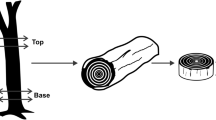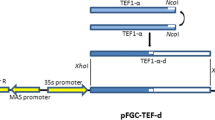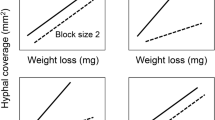Abstract
MANY countries lose thousands of pounds annually through natural staining of valuable wood. Usually the organism which causes staining is the fungus Botryodiplodia theobromae Pat1. Field and laboratory experiments have shown that Antiaris africana becomes stained blue within 4 d of felling2,3. The fungus enters the cut surface of the wood through the vessels and within 2 d heavily colonises the surrounding vasicentric parenchyma cells. Infection of ray cells occurs through the vasicentric parenchyma cells1. The fungus has two types of hyphae: some are stout and brown in colour, others are thin and hyaline. The brown hyphae are predominantly found in vessels, tracheids and fibres (Fig. 1), whereas the parenchyma cells are heavily infected by the hyaline hyphae.
Similar content being viewed by others
Article PDF
References
Olofinboba, M. O., and Lawton, J. R. S., Inst. W. Sci., 21, 6 (1968).
Momoh, Z. O., Technical note 36 (Dept. of Forest Research, Ibadan, 1966).
Olofinboba, M. O., Nig. J. For., 2, 54 (1972).
van Slyke, D. D., and Folch, J. J., J. Biol. Chem., 136, 509 (1940).
Olofinboba, M. O., Ann. Bot., 33, 339 (1969).
Kozlowski, T. T., and Keller, T., Bot. Rev., 32, 294 (1966).
Scheffer, T. C., and Lindgreen, R. M., Tech. Bull. (US Dept of A trie, Washington, D.C., 714, 1940).
Cartwright, K. S. C., and Findlay, W. P. K., Decay of Timber and its Prevention (HMSO, London, 1958).
Author information
Authors and Affiliations
Rights and permissions
About this article
Cite this article
OLOFINBOBA, M. Sap stain in Antiaris africana, an economically important tropical white wood. Nature 249, 860 (1974). https://doi.org/10.1038/249860a0
Received:
Issue date:
DOI: https://doi.org/10.1038/249860a0



